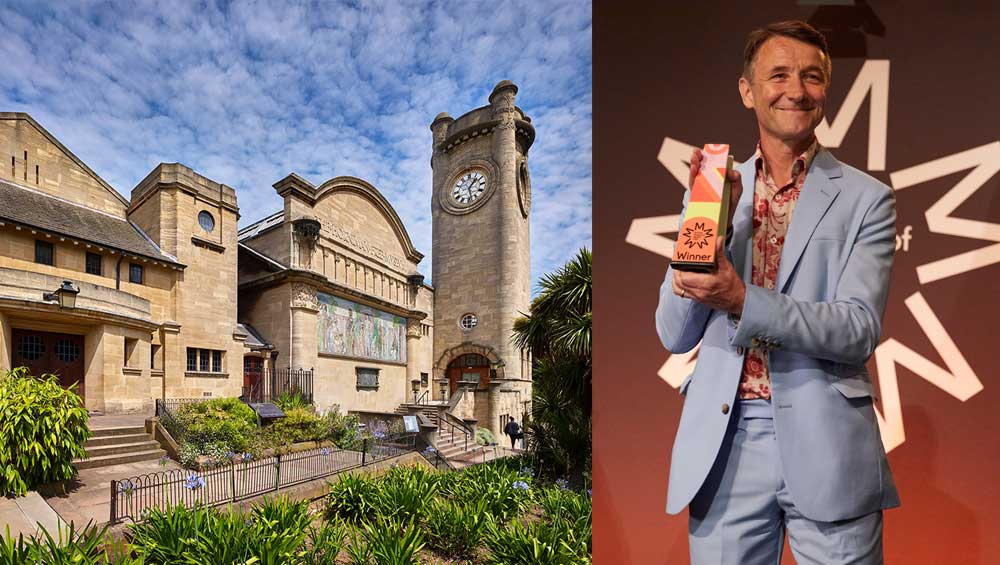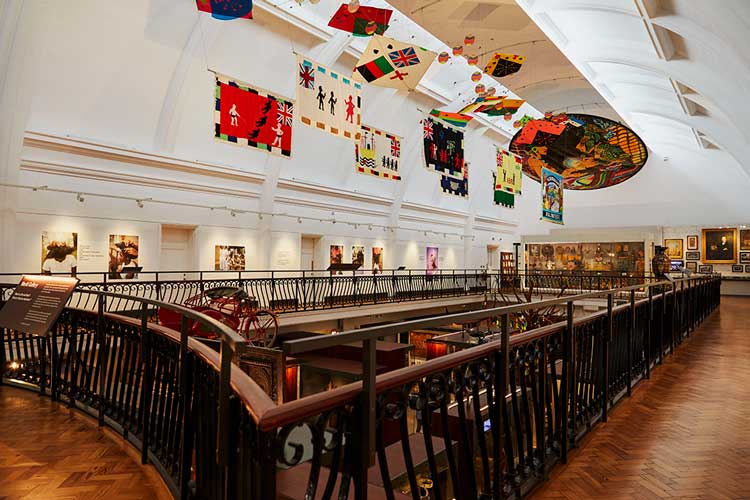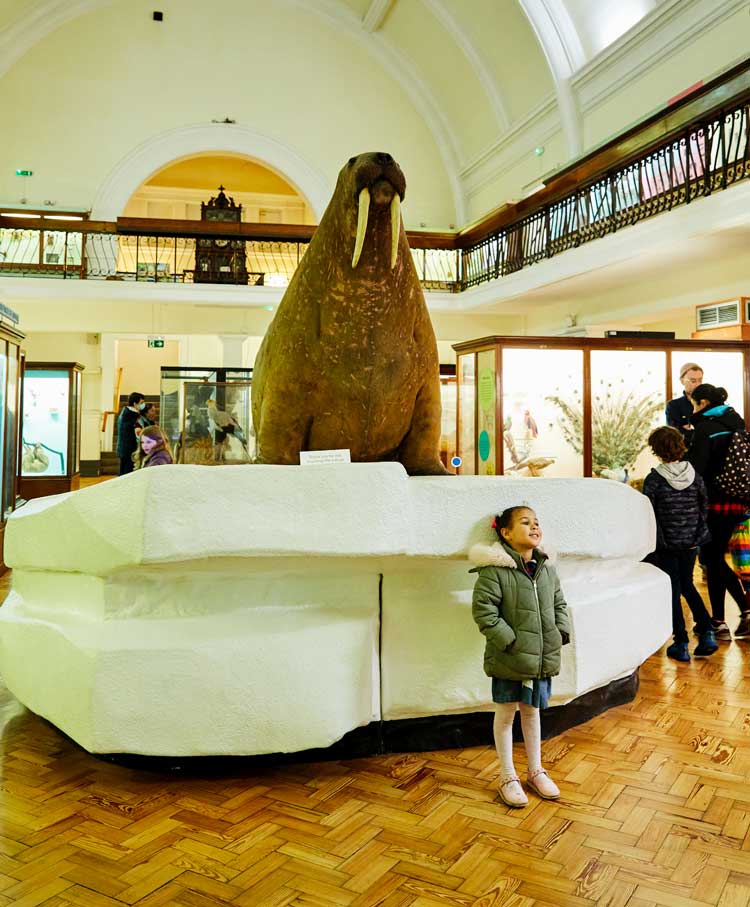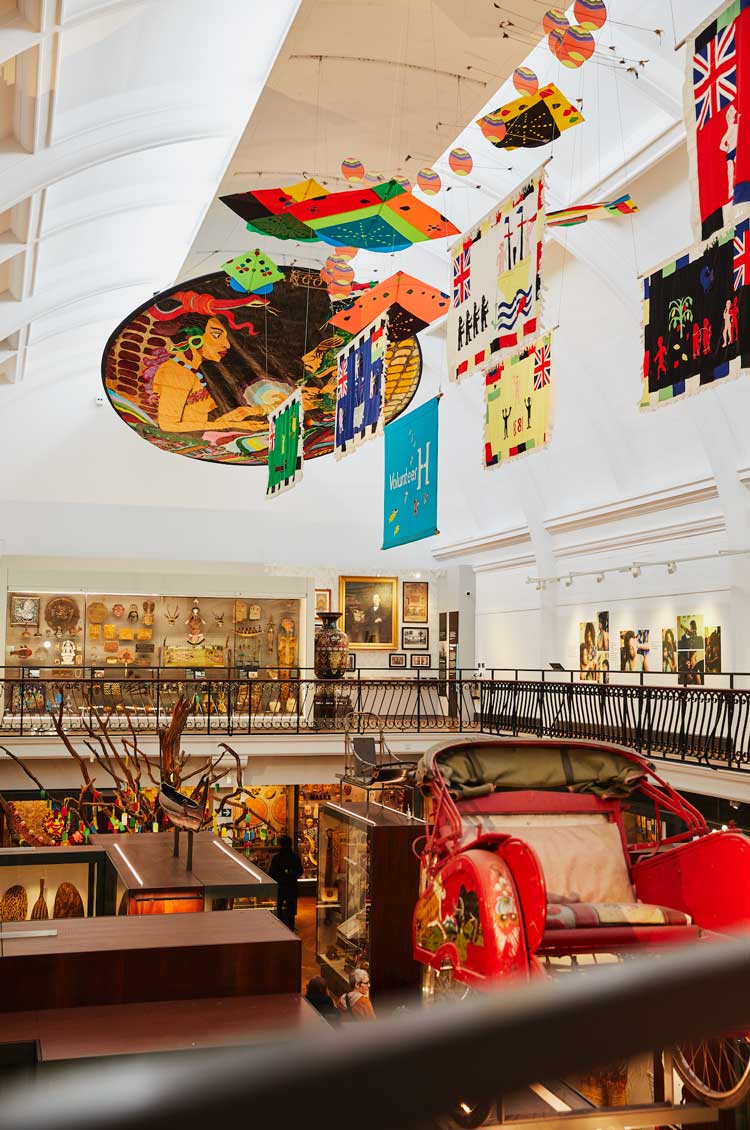
Nick Merriman, director of London’s Horniman Museum, receives the Art Fund Museum of the Year Award 2022.
by NICOLA HOMER
The Horniman Museum and Gardens in south-east London has won one of the biggest arts prizes in the world. Nick Merriman, the museum’s director, was presented with the £100,000 prize of the Art Fund’s Museum of the Year 2022 award by the BBC Radio 6 DJ and broadcaster Huw Stephens at a ceremony at the Design Museum on 14 July. The award ceremony was broadcast live on the BBC’s Front Row programme on BBC Radio 4 and The One Show on BBC One. It was a worthy victory and the prize money will enable the museum to extend its educational outreach programme during the school holidays.
Situated in Forest Hill, the Horniman is one of the only museums in London that presents environment, ecology and human cultures side by side at a global scale. The museum was recognised for redesigning its programme last year, following a time of reflection after the arrival of the pandemic, the climate emergency, and the murder of George Floyd in the United States. The Horniman’s Reset Agenda shifted the focus of its activities, so that it could reach out to diverse audiences, more representative of London. The programme set out a climate and ecology manifesto, and launched an initiative for young musicians, facilitating their engagement with the museum’s collection of instruments from around the world.

Horniman Museum and Gardens, London, Art Fund Museum of the Year winner 2022. © Emli Bendixen.
Jenny Waldman, the Art Fund’s director and the chair of judges for the Museum of the Year 2022 award, commented favourably on the museum’s holistic view: “The Horniman Museum and Gardens has now blossomed into a truly holistic museum bringing together art, nature and its myriad collections. Its values are woven through everything it now does, with a passionate team breathing life and meaning into every object, performance, plant and animal. In many ways it’s the perfect museum, and I would encourage everyone to go and experience all it has to offer.”
Dame Diane Lees, the director-general of the Imperial War Museums, and a judge for the Museum of the Year 2022, said: “The Horniman Museum and Gardens are championing the natural environment, commissioning artists and music festivals, to bring the eclectic collections of Frederick Horniman new relevance with diverse communities. They are setting the agenda for how a traditional museum can reinvent itself through powerful ideas.”

Horniman Museum and Gardens, London, Art Fund Museum of the Year winner 2022. © Emli Bendixen.
The 2022 edition of the Art Fund Museum of the Year award championed organisations whose achievements told the story of museums’ creativity and resilience, and particularly focused on those engaging the next generation of audiences in innovative ways. In addition to Waldman, Lees and Stephens, this year’s judging panel included the artist and educator Harold Offeh and the cultural historian and broadcaster Janina Ramirez.
This year’s other shortlisted museums were the Museum of Making in Derby, the People’s History Museum in Manchester, the Story Museum in Oxford and Tŷ Pawb (Everyone’s House) in Wrexham, each of which received a £15,000 prize in recognition of their achievements.
The Horniman, which has seen visitor numbers increase fivefold in 30 years, now looks set to welcome more visitors, after receiving the substantial award. Studio International spoke by telephone to its director, Nick Merriman, about the organisation’s achievements, the funding climate for museums in London, and how the prize money will help to fund an educational outreach initiative and a programme of resident musicians.
Nicola Homer: Congratulations on winning the Art Fund Museum of the Year 2022 award. Could you tell me about the Horniman Museum and Gardens, and its programme in 2021, which was an achievement recognised by the judging panel of the Art Fund charity?
Nick Merriman: The Horniman Museum and Gardens has been on its current site from 1890, but its current building dates from 1901 and then subsequent extensions. It’s a museum of world cultures, so anthropology with a sub-section of worldwide musical instruments, which is, I’m told, the best collection in the world, natural history from all around the world, and an indoor aquarium that is more than a century old. That’s accompanied by 16.5 acres [6.7 hectares] of gardens with a fantastic view over central London, a nature trail, a butterfly house and an animal walk of live domesticated animals. The museum has a family audience, predominantly: 75% are local to south-east London and the adjacent counties.
For 2021, what we did was down to the fruits of our Reset Agenda, which we formulated during the first Covid lockdown, where we said the global pandemic, from some points of view, was to do with our poor handling of the environment, and the way in which zoonotic diseases have been transferred to humans. At the same time, of course, [there was] the murder of George Floyd, leading to the resurgence of the Black Lives Matter movement, and the Horniman being a museum with its roots in colonial times – Frederick Horniman was a tea merchant, who collected from the 1850s right up to the 1910s. So, coinciding with that and our realisation that we are the only museum in London where you can see nature and culture side by side, we decided that our Reset Agenda was primarily about accelerating work around diversifying our audiences, because our audiences don’t reflect sufficiently the population of London, working through our colonial legacy in a much more explicit way, what it means to be a museum with its history in the colonial period. We know that the families who predominate in terms of visitors would be parents or grandparents, who are very worried about the future that the small children they’re bringing in will grow up in, who often feel overwhelmed. So, it was all about positive ways of engaging people practically in solutions or reactions towards the climate and ecological emergency.
So, specifically what we did in 2021 was a whole range of things. Because our musical instrument collection is so significant, we realised we weren’t linking that to young black audiences who were mad about music, but don’t see the Horniman as a place for them. We developed a project called 696, which was the name of a police risk assessment that was used disproportionally to shut down black music venues. We had a resident musician programme, young musicians from the local area. We facilitated them to come in and engage with our collection of instruments from around the world, sample some of the sounds, and incorporate this into new work, which we showcased in gigs in the Horniman. That took place in the context of a wider programme of larger-scale concerts through last summer, one example of which was the Jerk Cookout, which the Horniman did up to about 10 years ago, and then discontinued, because in a way the crowds it attracted were too large. And we had feedback when we were looking at diversifying our audiences, feedback from the Caribbean community, which said that when we stopped doing Jerk Cookout, they felt they weren’t welcome any more. So, putting that back again was a real signal around our openness to wider audiences. We did a programme called Rethinking Relationships and Building Trust Around African Collections, which was working with colleagues and students in Kenya and Nigeria on the material that we hold from those countries about thinking of longer-term, positive relationships, and what that might mean. Part of that included a community action research project, where we trained young African and Caribbean diaspora people in how to research the museum archive to answer questions that were of interest to them.

Horniman Museum and Gardens, London, Art Fund Museum of the Year winner 2022. © Emli Bendixen.
On the environmental side, we developed an Environment Champions Club, which supported families who want to live more sustainably to do that, and to put them in touch with each other. That was online to begin with and now increasingly face to face. We did forest school training, so that we could develop a programme of outdoor learning activities as a new string to our bow. We raised funds to create a micro-forest along the South Circular, which bounds part of our site, which is a very noisy and polluted road. The micro-forest will grow quickly, tall trees competing against each other for the light, and that will be a barrier against sound and traffic pollution. So, in a way, the judges’ feedback was that it was the holistic view we took around these key objectives around intercultural understanding, climate emergency, widening audiences, nature and culture, combined on site in an overall vision ... It wasn’t one thing; it was a whole approach to everything that we did right across the board.
NH: I understand that the museum has shifted the focus of its activity to reach out to diverse audiences in London. What role does this programme of reaching out to wider audiences play in the life of the local community?
NM: Well, we have quite a diverse local community but, interestingly, 30 years ago, when the visitor numbers were much lower, at 200,000 a year, the audience was more diverse than it is now. In fact, it more or less reflected the diversity of London’s population as a whole. Pre-Covid, we had nearly a million visitors to site. So, the numbers have gone up fivefold in 30 years. But the big growth had been in a more middle-class audience, and that’s partly because Forest Hill, our local area itself, gentrified more, much as many parts of London, but also because of the discontinuation of some elements of programming such as the Caribbean Jerk Cookout. So, in terms of the role we play in the life of the local community, we have served a large middle-class audience very well indeed, and they comprise the bulk of our memberships, who come again and again several times a year. Some people come 50 times a year, once a week. What we’ve added to that, I suppose, is doing programming on site of the musical type that I mentioned and also doing outreach to sections of the community who currently don’t come into site. That has two impacts, one is that we engage with people on their home patch, whether it’s a local housing association or whatever. That’s valuable in and of itself, but it’s fairly small numbers. We’re also doing in-reach, where we encourage people to come and visit on site for the first time, if they haven’t been before, and we facilitate a lot of those visits.
.jpg)
Students visit the Horniman Museum and Gardens, London, June 2022. Photo: Amaal Said.
Because obviously we’re a museum and gardens, the gardens are a really great and accessible way of bringing people in. During the pandemic, during lockdown periods, the gardens remained open, and they became a really appreciated resource for the local community and a very diverse community. You can imagine we were particularly used by people who didn’t have gardens, who were used to living in flats and so on in lockdown. That was a really brilliant way of engaging a wider audience than we had, with what the Horniman is, and we got loads and loads of positive feedback on that. For our future programming, we’re prioritising much more programming in the gardens, outside. We’ve got a new project called Nature and Love. That’s because one way of overcoming climate anxiety and inaction is to appeal to the love of the next generation. But Nature and Love focuses particularly on opening up and providing more facilities for some of our outdoor activities. We know from audience segmentation work that we’ve done that there are segments of the population who don’t currently visit us, who are more diverse than our current visitors, and particularly like doing outdoor activities together as a family. So, everything we do is underpinned by a fairly sophisticated understanding of who does and who doesn’t come, and whether they are visitors or non-visitors, what they like to do in their leisure time, and ways in which we might be able to persuade them that we’ve got something to offer indoors or, particularly, outdoors.
NH: It sounds like you have a brilliant offer there.
NM: It’s very diverse. There’s something for everyone, as they say.
NH: I can appreciate that the Horniman is actively addressing climate change through its announcement in January 2020 of a Climate and Ecology manifesto. In terms of addressing the climate and ecological emergency, how is the museum active beyond its walls?
NM: Well, as I say, we’ve got this, what has been largely online, Environment Champions Community, as we’re calling it now, which links people who are out there in the community, want to live more sustainably and sometimes think well, just recycling the rubbish isn’t really enough, providing them with materials and connections, largely through a Facebook group of likeminded people. That’s in the digital realm. Most of our other activities are on site, so they’re divided into two things, one is basically getting our own house in order through a long-term and comprehensive decarbonisation plan and a plan to enhance biodiversity on site, so that we can be living our values and an exemplar of our good practice. The other thing is using our large-scale audiences to engage people to become active citizens around responses to the climate crisis, but that’s mainly through exhibitions, activities and in fact the refurbishment of our natural history gallery, which will open in four years’ time. I suppose the only other way we do it off site is by being an example of good practice, as I say, to other colleagues in the arts and cultural heritage sector. I chair a sub-group of the National Museum Directors’ Council, which brings together all the national and regional museums, a sub-group on environment and ecology, and that’s a forum for discussing good practice around what museums can do, getting their own act together and engaging the public, and particularly is focusing on some museum-specific issues such as loans and couriering, environmental conditions and so on. So, that’s, I suppose, us trying to hopefully help lead the changes that are needed in the museum and arts sector, so that we can become more sustainable in our operations and engage the public in being active citizens themselves.
NH: I’d like to ask you about the funding system for museums in the UK as, I gather that over the last two decades, the British government has reduced state funding for culture and encouraged museums to become more self-reliant. How are you finding the current funding climate?
NM: Well, the funding climate is obviously very challenging. Perhaps the first thing to say is that our main funder, the Department for Digital, Culture, Media & Sport, has been incredibly supportive during the crisis caused by Covid. Like most organisations, we’ve used furlough funding and we’ve also had the Covid relief funding from the government, which has covered our losses from income generation. I suppose the other thing to say is that, of course, what Covid did do, given that nobody had predicted it, is expose the vulnerability of the greater reliance on commercial income for museums. Now for the Horniman, 70% of our funding is still public funding, so we raise the other 30%. So, obviously, most of that 30% disappeared, although not all of it, because some of it is through memberships and so on, some of which continue. For some of the central London national museums, it’s reversed. Some of them have 30% public funding and 70% is commercial, and most of that fell off a cliff because of closure and international tourists not coming. And they did have to be bailed out to quite a considerable extent by government. As I was saying, it exposed the vulnerability of that, and has caused many of us to rethink our business model. The Horniman is not quite in the same boat as some of the big London national museums. But for all museums, for the last two decades, the move to become more self-reliant has been accompanied by an assumption on the part of funders, and even from museums themselves, that there is a requirement to do more each year, have more visitors, raise more money, more self-generated income, build more buildings, etc. What Covid did was show that this model of constant growth is not a sustainable one.
A lot of us are now thinking about what a sustainable business model would look like, and obviously it will differ from museum to museum. It doesn’t mean the big museums will cease to have international exhibitions, or cease doing blockbusters. But it does imply that, certainly for the Horniman, as I’ve said earlier, we’re not now going for, and our board endorses this, increasing our numbers of visitors each year. It’s about widening the diversity of our visitors. That itself doesn’t necessarily mean a drop in income, but it might for some museums. Perhaps it’s easiest to say: “Well, as long as we get international tourists spending money, we’ll be fine.” The pandemic was a reminder about the social mission of museums and that public funding, no matter what its level, does bring with it an expectation that it’s spent for the benefit of the whole public. And certainly, for the Horniman, having a high level of public funding, that’s why we think removing as many barriers as possible to participation is absolutely what our mission should be about, not about just simply growth for the sake of it.
NH: The Horniman is the lead partner in the Museums and Galleries Network for Exhibition Touring (Magnet), a network of 10 museums and galleries set up in 2020, which are joining resources to share their collections with diverse national audiences. Can I ask you what lessons you are learning from this project?
NM: Sure. We’ve had a formal evaluation done of the Magnet network and the first exhibition produced by the network, called Hair: Untold Stories – which was started at the Horniman and is next touring to Tullie House Museum and Art Gallery in Carlisle and to Sheffield Museums. So, a couple of headlines really: one is that there is a real appetite for this kind of collaborative working and, much to my pleasure, we managed to keep the network going all through Covid. We had one face-to-face meeting with all the partners and then we went into lockdown. So, one of the things that partners reported was that, while they were dealing with all the difficulties with their own institutions, it was quite refreshing and they looked forward to it, to be able to talk to colleagues online about working together and about something that was going to take fruit in a few years’ time. Having said that, one of the other, in a way slightly contradictory, or contrasting lessons, is that it’s much more difficult to collaborate than it is to do your own thing. Certainly, in exhibition terms, it’s easier in many ways, to just say: “OK, we’re going to do this exhibition, and then it will close, and we’ll dismantle it.” It’s more complicated to work with two or three other partners, and think about all the tour arrangements, the couriering, the loan agreements and so on. So, it’s hard work ... The overall thing is the pilot, funded by the Art Fund, has been a great success, which the evaluation demonstrated very amply. Building on that, we’re just putting together a bid to Arts Council England for three years of funding to explore different models with the aim of producing a sustainable business model long-term, so that the network will be able to really stand on its own two feet, and just keep going for the foreseeable future.
NH: I’d like to ask you now about how you plan to spend the prize money from the Art Fund Museum of the Year 2022 award on forthcoming museum projects. How will it make a difference?
NM: It’s already made a difference, of course, because it’s been a fantastic boost to all our staff and volunteers and trustees, and our visitors, including our members, because coming out of two difficult years, it really is an endorsement of the direction we’re going in and the accolade most needed to bring everyone together. It will almost certainly result in more visitors, because the publicity has been absolutely fantastic. The Horniman, again not being in central London, but in a London suburb, doesn’t usually get the kind of publicity that the Art Fund prize has generated, particularly in the national media. That’s been fantastic.
In terms of the prize money itself, we’re going to do two things with it, one is to continue the programme of resident musicians that I talked to you about for at least another three years, whereby young musicians will come in and spend some time with our musical instruments, sample the sounds, use them as inspiration for the creation of new work, which we’ll then showcase in a series of live concerts on our site. The other bit will be a series of free outdoor learning activities for children in the school holidays, particularly focused at schools that have a high proportion of children on free school meals. With concerns about food poverty, although we wouldn’t make a big fuss about this, it would be really clear that food would be provided as part of the sessions. The footballer Marcus Rashford highlighted this issue of free school meals not being available during school holidays, and since he did that, we’ve had the cost of living crisis exacerbated even further. So, we think not only the content of some of the educational work we will provide during the holidays, but also the ability to provide some nourishing food, is going to be really important.
NH: That’s excellent. It sounds like nourishment for the soul, in a sense.
NM: Exactly, physically and mentally.
NH: Indeed. It sounds like a very worthy endeavour to do this outreach programme.
• Visit the Horniman Museum and Gardens website to see its programme of exhibitions and events: https://www.horniman.ac.uk/whats-on.
.jpg)
Art Fund Museum of the Year Award 2022, announcement at the Design Museum in London.
Click on the pictures below to enlarge